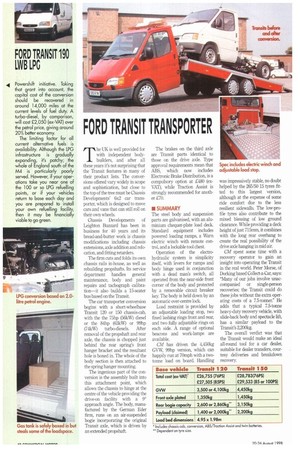FORD TRANSIT TRANSPORTER
Page 44

If you've noticed an error in this article please click here to report it so we can fix it.
The UK is well provided for with independent bodybuilders, and after all these years it's not surprising that the Transit features in many of their product lists. The conversions offered vary widely in scope and sophistication, but close to the top of the tree must be Chassis Developments' 6x2 car transporter, which is designed to move cars and vans that can still roll on their own wheels.
Chassis Developments of Leighton Bu=rd has been in business for 40 years and its bread-and-butter work is chassis modifications including chassis extensions, axle addition and relocation, and fitting retarders.
The firm cuts and folds its own chassis rails in-house, as well as rebuilding propshafts. Its service department handles general maintenance, body and paint repairs and tachograph calibration—it also builds a 15-seater bus based on the Transit.
The car transporter conversion begins with a short-wheelbase Transit 120 or 150 chassis-cab, with the the 75hp (56kW) diesel or the 84hp (63kW) or 99hp (74kW) turbo-diesels. After removal of the propshaft and rear axle, the chassis is chopped just behind the rear spring's front hanger bracket and the resultant hole is boxed in. The whole of the body section is then attached to the spring hanger mounting.
The ingenious part of the conversion is the assembly built into this attachment point, which allows the chassis to hinge at the centre of the vehicle providing the drive-on facility with a 90 approach angle. The body, manufactured by the German Eder firm, runs on an air-suspended bogie incorporating the original Transit axle, which is driven by an extended propshaft. The brakes on the third axle are Transit parts identical to those on the drive axle. Type approval requirements mean that ABS, which now includes Electronic Brake Distribution, is a compulsory option at £480 (exVAT), while Traction Assist is strongly recommended for another £70.
• SUMMARY
The steel body and suspension parts are galvanised, with an aluminium chequer-plate load deck. Standard equipment includes powered loading ramps, a Warn electric winch with remote control, and a lockable tool chest.
Operation of the electrohydraulic system is simplicity itself, with levers for ramps and body hinge used in conjunction with a dead man's switch, all operated from the near-side front corner of the body and protected by a removable circuit breaker key. The body is held down by an automatic over-centre lock.
Load restraint is provided by an adjustable loading stop, two fixed lashing rings front and rear, and two fully adjustable rings on each side. A range of optional beacons and work-lamps are available.
CM has driven the 4,450kg GVW, 99hp version, which can happily run at 70mph with a twotonne load on board. Handling
was impressively stable, no doubt helped by the 265/50 15 tyres fitted to this largest version, although at the expense of some ride comfort due to the less resilient sidewalls. The low-profile tyres also contribute to the mixed blessing of low ground clearance. While providing a deck height of just 715mm, it combines with the long rear overhang to create the real possibility of the drive axle hanging in mid air.
CM spent some time with a recovery operator to gain an insight into operating the Transit in the real world. Peter Morse, of Dorking based Collect-a-Car, says: "Many of our jobs involve unaccompanied or single-person recoveries; the Transit could do these jobs without the extra operating costs of a 7.5-tonner." He adds that a typical 7.5-tonne heavy-duty recovery vehicle, with slide-back body and spectacle lift, has a similar payload to the Transit's 2,200kg.
The overall verdict was that the Transit would make an ideal all-round tool for a car dealer, suitable for dealer transfers, courtesy deliveries and breakdown recovery
Base vehicle Transit 120 Transit 150
Total cost (ex-VAT)* e26,755 (76PS) £28,783(76P5) 07,505 (85PS)
09,533 (85 or 100PS)
GVW ' 3,500 or 4,100kg 4,450kg Front axle plated 1,350kg 1,450kg Rear bogie capacity
2,600 or 2,860kg—
3,150kg Payload (claimed)
1,400 or 2,000kg—
2,200kg Load bed dimensions 4.95 x 1.98m
• Includes chassis cab, conversion, ABS/Traction Assist and twin batteries. ** Dependent on tyre size








































































































